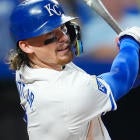- Draft Prep Tiers: C | 1B | 2B | SS | 3B | OF | SP | RP
- Heath's Sleepers | Breakouts | Busts |
- Scott's Top 100 prospects | Sleepers | Breakouts | Busts
One good thing about living at the extremes is, you can sacrifice and still be better than just about anyone else.
Take Giancarlo Stanton, for example. Long known for his gargantuan power, Stanton actually dialed it back in 2017, dropping from second in average exit velocity in 2016 to sixth in 2017. That may not sound like a big drop, but he went from averaging 93.9 mph on his batted balls to 91.9; the drop is even more pronounced when you account for his 95.9 mph average exit velocity in 2015. His hard-hit rate similarly dipped from 49.7 percent in 2015 to 42.9 in 2016, and then to 38.9 percent in 2017.
Stanton, of course, also had the best season of his career by a wide margin in 2017. He increased his contact rate to 70.4 percent, the highest it's ever been, and he swing-and-missed less than ever before. Because he has so much power to spare, Stanton stood to gain from becoming a more consistent hitter overall.
It worked for him, and it could work for Joey Gallo, too.
Gallo, of course, is an even more extreme hitter than Stanton has ever been. He struck out in 36.8 percent of his plate appearances in 2017, sported a 46.4 percent hard-hit rate, and had a mammoth 19.2 swinging strike rate. He is always going to be a high-strikeout batter; he knows it, and pitchers know it too, throwing him just 36.1 percent of pitches in the strike zone.
Could he benefit from the same kind of adjustments Stanton made last season? Certainly, and according to The Athletic's Eno Sarris, Gallo is working on using all fields with two strikes. Sarris is passing on a colleague's reporting on Gallo's approach, but there are reasons to be at least somewhat optimistic: Gallo has struck out just nine times in 44 plate appearances so far in the spring.
That may not sound much, but consider this: Gallo had just one stretch last season when he was similarly strikeout-averse. From Aug. 20 through Sept. 6, he struck out just 11 times in 45 plate appearances. Even a small reduction in strikeout rate, say from 37 percent to 32 percent, could get Gallo to the .230-.250 range in batting average. Plus, history shows that strikeout rate is one of the skills hitters actually do improve as they age.
That's not the only reason to think Gallo has more upside than he even showed in an impressive 2017 campaign. The Rangers are taking the somewhat unorthodox approach of having Gallo bat second, behind Delino DeShileds, with the hopes that Gallo will see more fastballs and fewer infield shifts with a speedster on base in front of him.
Even if it doesn't lead to better hitting opportunities for Gallo, it will lead to more hitting opportunities for him, and that's a very good thing on its own. Last season, nearly all of Gallo's plate appearances came in the bottom half of the lineup for the Rangers because he started just one game batting higher than fourth. Last season, the Rangers received 728 plate appearances from the No. 2 spot in the lineup, compared to 686 from No. 5, and they decline further from there.
Gallo managed to hit 41 homers in 2017, with 165 combined runs and RBI and seven steals, despite getting just 532 plate appearances. He played 145 games, but entered 10 games as a replacement in the fifth inning or later, and had seven more where he was pulled after just three plate appearances. The Rangers' primary No. 2 hitters in 2017 (Elvis Andrus and Shin-Soo Choo), by comparison combined for 655 plate appearances in 147 games when they started in the two hole.
Give Gallo that many plate appearances at his 2017 pace, and you're looking at 50 homers, 104 runs, 99 RBI and even nine steals. If he improves his batting average even a little bit -- say, to the .230 mark he managed after the 2017 All-Star break -- and, well … it's not hard to see him making the leap to top-20 hitter status, even with the batting average drag. And a potential second-rounder in OBP or OPS leagues.
Gallo is a special hitter. The key to becoming even better might be to follow in Stanton's footsteps and become just a little bit more normal.

















